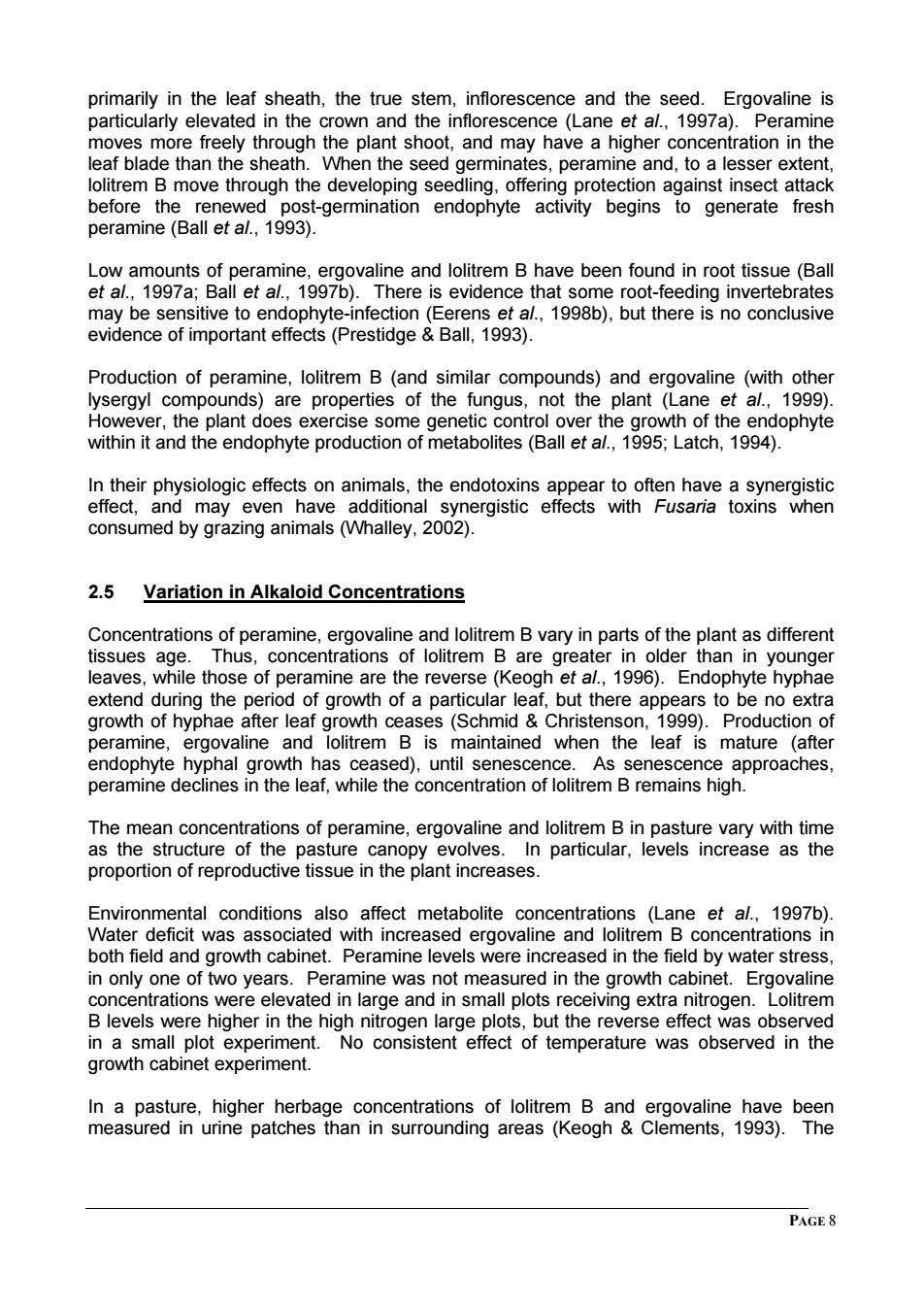正在加载图片...

primarily in the leaf sheath,the true stem,inflorescence and the seed.Ergovaline is particularly elevated in the crown and the inflorescence (Lane et al.,1997a).Peramine moves more freely through the plant shoot,and may have a higher concentration in the leaf blade than the sheath.When the seed germina tes,peramine and,to a lesser extent move through the develop ng see n against inse t attack betore the peramine( st-germination endophyte activity begins to generatef Low amounts of peramine,ergovaline and lolitrem B have been found in root tissue(Ball et al..1997a:Ball et al..1997b).There is evider nce that so me root-feeding inve may be sensitive to endophyte-infection(Ee ens et al.,1998b).but there is no conclusive evidence of important effects(Prestidge Ball,1993). Production of peramine,lolitrem B (and similar compounds)and ergovaline (with other lysergyl compounds)are properties of the fungus,not the plant (Lane et al.,1999). However,the plant does exercise some genetic control over the growth of the endophyte within it and the endophyte production of metabolites(Ball et al.,1995:Latch,1994). may even have additiona 2.5 Variation in Alkaloid Concentrations Concentrations of peramine.eraovaline and lolitrem b vary in parts of the plant as different tissues age Thus,concentrations of lolitrem B are greater in older than in younger leaves,while those of peramine are the reverse(Keogh et al.,1996).Endophyte hyphae extend during the period of growth of a particular leaf,but there appears to be no extra growth of hyphae after leaf growth ceases(Schmid Christenson,1999).Production of beramine. ergovaline and lolitrem B is maintained when the leaf is mature (after endophyte hyphal growth has ceased),until senescence.As senescence approaches, peramine declines in the leaf,while the concentration of lolitrem B remains high. The an concent tions of peramine,ergovaline and lolitrem r reproa Environmental conditions also affect metabolite concentrations (Lane et al 1997b) Water deficit was associated with increased ergovaline and lolitrem B concentrations in both field and growth cabinet.Peramine levels were increased in the field by water stress in only one of two years.Peramine was not measured in the growth cabinet.Ergovaline concentrations were elevated in large and in small plots receiving extra nitrogen.Lolitrem B levels were higher in the high nitrogen large plots,but the reverse effect was observed in a small plot experiment.No consistent effect of temperature was observed in the growth cabinet experiment PAGE8primarily in the leaf sheath, the true stem, inflorescence and the seed. Ergovaline is particularly elevated in the crown and the inflorescence (Lane et al., 1997a). Peramine moves more freely through the plant shoot, and may have a higher concentration in the leaf blade than the sheath. When the seed germinates, peramine and, to a lesser extent, lolitrem B move through the developing seedling, offering protection against insect attack before the renewed post-germination endophyte activity begins to generate fresh peramine (Ball et al., 1993). Low amounts of peramine, ergovaline and lolitrem B have been found in root tissue (Ball et al., 1997a; Ball et al., 1997b). There is evidence that some root-feeding invertebrates may be sensitive to endophyte-infection (Eerens et al., 1998b), but there is no conclusive evidence of important effects (Prestidge & Ball, 1993). Production of peramine, lolitrem B (and similar compounds) and ergovaline (with other lysergyl compounds) are properties of the fungus, not the plant (Lane et al., 1999). However, the plant does exercise some genetic control over the growth of the endophyte within it and the endophyte production of metabolites (Ball et al., 1995; Latch, 1994). In their physiologic effects on animals, the endotoxins appear to often have a synergistic effect, and may even have additional synergistic effects with Fusaria toxins when consumed by grazing animals (Whalley, 2002). 2.5 Variation in Alkaloid Concentrations Concentrations of peramine, ergovaline and lolitrem B vary in parts of the plant as different tissues age. Thus, concentrations of lolitrem B are greater in older than in younger leaves, while those of peramine are the reverse (Keogh et al., 1996). Endophyte hyphae extend during the period of growth of a particular leaf, but there appears to be no extra growth of hyphae after leaf growth ceases (Schmid & Christenson, 1999). Production of peramine, ergovaline and lolitrem B is maintained when the leaf is mature (after endophyte hyphal growth has ceased), until senescence. As senescence approaches, peramine declines in the leaf, while the concentration of lolitrem B remains high. The mean concentrations of peramine, ergovaline and lolitrem B in pasture vary with time as the structure of the pasture canopy evolves. In particular, levels increase as the proportion of reproductive tissue in the plant increases. Environmental conditions also affect metabolite concentrations (Lane et al., 1997b). Water deficit was associated with increased ergovaline and lolitrem B concentrations in both field and growth cabinet. Peramine levels were increased in the field by water stress, in only one of two years. Peramine was not measured in the growth cabinet. Ergovaline concentrations were elevated in large and in small plots receiving extra nitrogen. Lolitrem B levels were higher in the high nitrogen large plots, but the reverse effect was observed in a small plot experiment. No consistent effect of temperature was observed in the growth cabinet experiment. In a pasture, higher herbage concentrations of lolitrem B and ergovaline have been measured in urine patches than in surrounding areas (Keogh & Clements, 1993). The PAGE 8